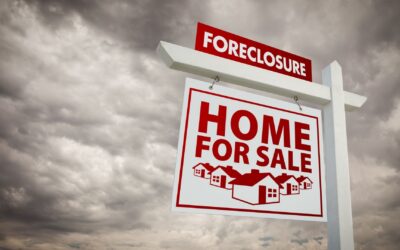Lots of real estate Fix/Flip investors (and HGTV reality TV shows) focus on the basic house flip, i.e., rehabbing and selling a single family residence (SFR). But a talented investor can use a similar process to flip a duplex, triplex, or 4-plex, while typically making bigger profits than can be made on an SFR. The complexity of rehab is about the same, but the price point/value of a common tri-plex or 4-plex is usually higher than the standard SFR. And by making strategic improvements to the condition and financial cash flow of the property, the principle of the Cap Rate Multiplier can give profits a nice boost!
I will illustrate this concept by using the example of a property that we recently purchased, strategically rehabbed, and then sold for a sweet gross profit of over $100,000…
The Project
We buy our properties from a variety of sources, and nearly all of them are off-market (not on MLS) when we purchase them. We are direct to the owner on most of these properties, but this particular opportunity came through a relationship we have with another wholesaler investment company. That company had negotiated and put this deal under contract, and we purchased the right to the contract from them. The property was priced fairly for what it was at that time (a tired property in a class B neighborhood), but we saw some significant upside potential.
The property itself was a 4-plex in a middle class neighborhood in Mesa, Arizona, just minutes from the new Chicago Cubs spring training facility, and from Arizona State University’s campus in Tempe. The front unit consisted of 3 bedrooms and 2 baths that had the look and feel of a house, complete with a dedicated 1-car garage. Attached to the back of that unit were 3 other units, each with 2 bedrooms and 2 bathrooms. In addition, there were 4 other garage spaces available, but they were only functioning as carports in recent years, as the garage doors and motors were defective.
When we purchased the property, the 3-bedroom unit was vacant and in need of upgrades, and one of the 2-bedroom units was going to be vacant shortly afterward. So we knew we would have the ability to upgrade 2 of the 4 units right off the bat. In addition, there was some deferred maintenance to the structure that would need attention.

View of the 4-Plex (Subject Property) from the Street
Our Strategy
Our primary strategy on this property was to Fix/Flip it (although we also considered the BRRRR method of holding it as a rental). To maximize the flip potential on this property, we needed to determine how to get the most bang for our buck. In other words, the key was to target those areas where we could force the most appreciation into the property, without going overboard on the budget. Increase the monthly cash flow, and you increase the value of the property. The easiest way to increase the monthly cash flow is to either eliminate unnecessary expenses, or to increase rental income.
Here are the two key areas that we knew would give us the best bump in monthly cash flow on this particular project:
1. Remodel the 2 vacant units
We knew that if we upgraded the condition of the 3 bedroom/2 bath/1 car garage unit, we would be able to find a tenant that would pay more than the ~$1050/month value that the current condition warranted. So we upgraded the kitchen and baths, painted the interior, and made numerous other cosmetic repairs. In the end, we quickly found a tenant willing to pay $1300/month, and we signed them to a 13-month lease.
For the 2 bedroom, 2 bath unit, we also made a number of upgrades when it became vacant shortly after our purchase. Most notably, we put in new flooring throughout and updated the kitchen and baths. This unit, which was previously rented at $700/mo., was then able to be rented for $995/mo.
2. Fix the 4 additional garage spaces, and make them available for rent
The large, 3/2 unit had its own, functioning 1-car garage. But there were 4 other garage spaces in a separate garage and the 2 doors and motors for those spaces were inoperable. However, for less than $1,000 we were able to repair the garage motors and doors allowing us to utilize the garages as additional income producers. By making these garage spaces available for $45/month each, that provided an extra $180/month in potential income.

4 additional Garage spaces that were repaired and made available for additional monthly income
In addition to the 2 key areas above, there were several other items that we needed to address, that wouldn’t necessarily pump up the cash flow, but were needed for safety, asset protection, or as an ancillary amenity to make the property a nicer place to live. The old metal and concrete staircase that led up to the 2nd floor units was rusted and in poor condition, so we welded new metal in a number of areas and shored it up. The flat roof over the 4-car garage showed signs of past leaks, so we resealed it and added a coat of elastomeric roofing paint on top.
We also saw the opportunity to utilize some underused space behind the structures, and convert it into an attractive common area amenity, available just to our tenants. The back yard area had been open on two sides, to foot traffic. We fenced it in, installed a locking gate with access only for our tenants, and provided a BBQ grill and a picnic table as a gathering spot. We also moved the trash receptacle area, allowing us to create several more dedicated parking spaces for tenants or guests. These additional uncovered parking spaces allowed us to be able to then charge an uplift for those tenants that wanted to upgrade from an uncovered space to a garage space with (now working) garage doors/motors. So while theses amenities (which cost us less than $1500 to add) didn’t directly correlate to increased Cash Flow for the project, they made for a better living experience for our tenants and helped us indirectly by providing value that the other surrounding properties didn’t offer, and thereby the opportunity to charge extra for it.

Private amenity added for our tenants to use
The (Magical) Cap Rate Multiplier
When selling multi-unit income properties like this, sales values can be based on the comparative sales approach, like SFRs typically are, or can be based on what an investor will pay for a stream of cash flow. This later technique is called the capitalization rate, or Cap Rate, approach and it’s based on simple math. If the property is expected to deliver $25,000 a year in net cash (after all direct expenses), and an investor is generally willing to earn a 6.0% return for investing in that kind of property in that area (i.e., based on condition and location of the property), then the value of the property would be approximately $25,000 / 0.06 = $416,667. Working it backwards, an investment of about $417,000 at a 6% return, would yield about $25,000/year of cash flow/profit, or just over $2,000/month.
So to determine the value of an investment property using the Cap Rate method, you take the net annual Cash Flow and divide it by the targeted Cap Rate return; that is, the rate that a savvy investor would be willing to pay to purchase that stream of cash flow. When you divide a number (numerator) by another number (denominator), and that denominator equates to a fairly low percentage (0.06 or 6% in the example above), notice that the result of your math becomes a much larger number than the numerator. $25,000 / 0.06 = 416,667. Also note that this math operation can be inverted, and will still produce the same result. 6% goes into 100% approximately 16.6667 times (100 / 6 = 16.6667). So you can also do the Cap Rate math as follows:
$25,000 x 16.6667 = $416,667
This factor (for instance, 16.6667 above) is what I like to refer to as the Cap Rate Multiplier. I like to visualize our profits coming to us in this manner: create value by improving a project’s Cash Flow, and get rewarded to the tune of a nice multiplier like 16.6667. Think about it – if you do something to increase the projects Cash Flow by just $100/month, that becomes $1200/year multiplied by 16.6667, equaling forced appreciation of ~ $20,000. Could you put in coin-operated laundry and make $100/month extra cash flow from it? It may cost you about $1,500 to buy the equipment, but if each family does 3 loads of laundry a week, a 4-plex could generate that extra $100/mo.
Your investment of $1,500 or so just increased your cash flow by $100/mo. and your sales price by $20,000 at a 6 cap. That’s a 16x increase in value for the extra cash flow, plus a 13x return on your incremental investment!
Choosing the Right Cap Rate for the Project
As alluded to previously, when estimating what the selling Cap Rate should be on a particular project, you will want to consider the location of the property, as well as the quality of the property. A beautiful new Class A building, chock full of amenities, in a very nice and sought after neighborhood, will allow you to sell the project at a lower Cap Rate than a run-down building in an undesirable neighborhood. So in this case, all cash flow is not created equal.
What I mean by that is that an educated investor will typically accept a lower return (or cap rate) on their money if the project consists of a very nice property in a nice area. For instance, they may accept a 5% return (cap rate) on this project, whereas if they invested in a rough building in a rough area, they may require a 9 or 10% cap rate. Is the investor prejudiced against the less attractive building/area? Perhaps there is some psychology in it, as we often like to invest in areas we like to be in, or envision ourselves living in. But mainly, the newer or better maintained properties in nicer areas typically correlates to less deferred maintenance needed over the next few years, less chance of fire or insurance claims, and sometimes better insulation from economic downturns, which often affect the lower, working-class neighborhoods first.
HINT: in areas where affordable housing is in high demand, like the Phoenix metro area, you can often find better fix/flip deals in the class B/C neighborhoods than you can in a class A neighborhood like North Scottsdale. If you buy a class C property in a class B neighborhood, and then improve it to a class B or B minus property, you can then find buyers who will purchase it from you at a lower cap rate (higher price for you) because you have forced appreciation and transformed the property to a higher classification level.
Cap Rates, like real estate in general, are based on local dynamics, so you will want to understand the area that your project is in, just as if you were fix/flipping a house in a subdivision. For the 4-plex subject property in Mesa, I estimated the Cap Rate to be about 6.5%, meaning that an informed investor would purchase the property if they felt assured of getting a net annual cash flow of about 6.5% on their investment. Inverting that, the 6.5% becomes a Cap Rate Multiplier of 15.385 (100 / 6.5).

New flooring & remodeled kitchen in the 2-bedroom unit
The Skinny Behind the Big Fat Profits
Remember the 2 key areas that we identified above, to force appreciation into this project? Remodeling the 2 vacant units and repairing and renting the 4 extra garage spaces? Well, let’s look at the impact of those initiatives on the Sales Value of the project:
- Remodel 3/2 unit: increased rental income by $250/mo.
- Remodel 2/2 unit: increased rental income by $295/mo.
- Rent 4 Garage spaces: increased income by $180/mo.
Total forced increase in Cash Flow: $725/mo. x 12 months = $8,700/year
Apply the Magic of the Cap Rate Multiplier: $8,700 x 15.385 = $133,850 Higher Sales Value
Simply put, by making improvements which led to an increase in cash flow of $725/mo., we forced additional value of about $134,000. That is based on a 6.5% Cap Rate, as we used the Cap Rate Multiplier of 15.385. The best part is that it only cost us a fraction of that amount in rehab, in order to create such a large amount of forced appreciation.
We purchased the property for $435,000, made the improvements, and listed it on MLS three months later, at a 6.5% cap rate. We got offers immediately, and closed the sale a month later, at $589,900.
All in all, we spent ~$23k in targeted rehab to force the appreciation, plus $2k in property taxes and utilities. We purchased it wholesale, and sold it retail, incurring some closing costs on both sides, and paid some realty commissions on the sale. Here is a summarized tally, along with other key metrics related to this deal:

Here is a look at the Project Timeline:
| Rehab and Leasing | 3.25 months |
| . | |
| MLS listing until Accepted Offer | 0.25 months |
| . | |
| Escrow Period until Closing | 1.00 month |
| . | |
| Total Project Time | 4.50 months |
| . | |
| Cap Rate Multiplier for this Project | 15.385 (100 / 6.5) |
| . | |
| Ratio of Created Value to Cost | 5.8 (134k forced appreciation / 23k rehab cost) |
Every $1 spent on rehab generated nearly $6 of forced appreciation/higher sales value.
Summary
The key concepts I aimed to communicate in this article are as follows:
-
- Fix/Flipping a 2-4 unit property is not much more complex than flipping a Single Family Residence, but can offer higher returns;
- The Cap Rate Multiplier should be computed in advance for each project, based on the local market dynamics;
- Math can be fun, especially when you are creating massive value in your properties by spending nominally and letting the Multipliers do their work J;
- The correlation between 1) the cost to generate additional cash flow, 2) the amount of cash flow being generated, and 3) the Cap Rate Multiplier effect on Sales Value, is a powerful guide as to what improvements should be made to optimally force appreciation on the project;
- Unlike SFR remodels, where your sales price ceiling is usually capped by whatever the highest comparable sale was in the neighborhood, when dealing with income property like this 4-plex the sales price ceiling can be more elastic – a mathematical product of Net Cash Flow expected from the project, and the Cap Rate Multiplier.






